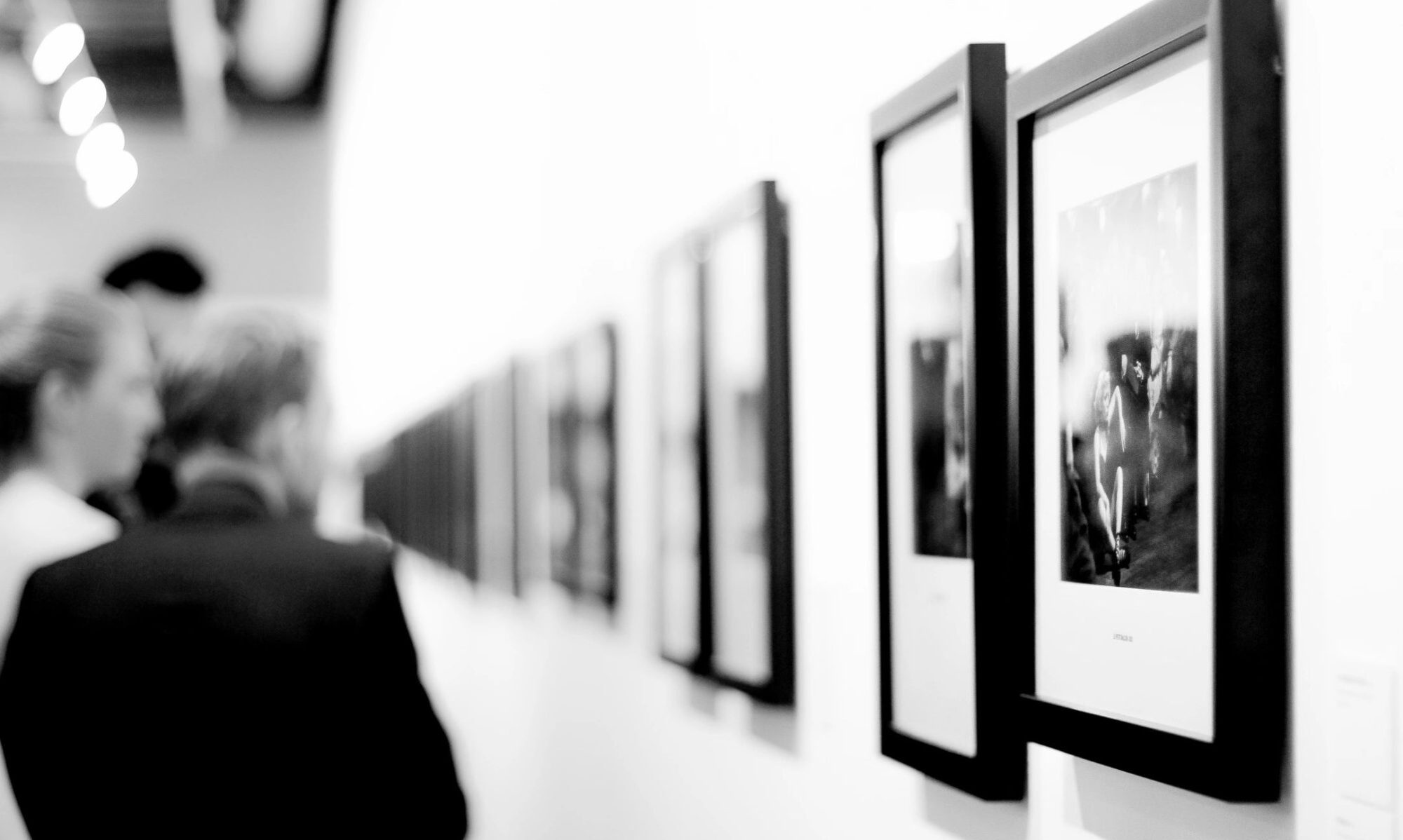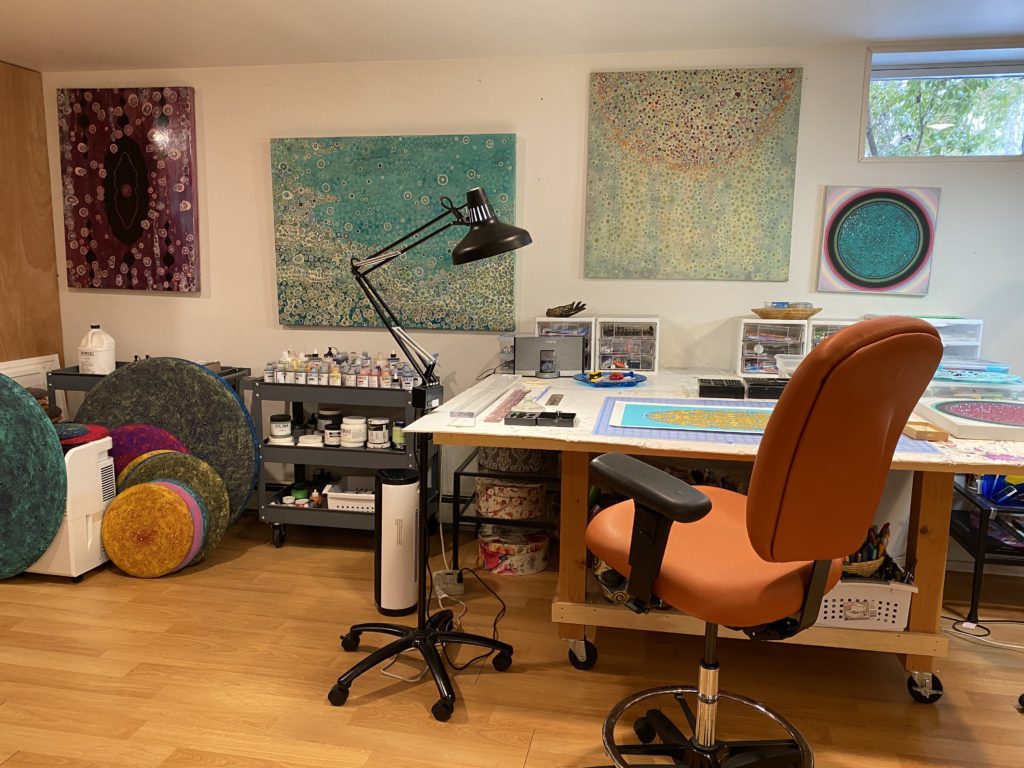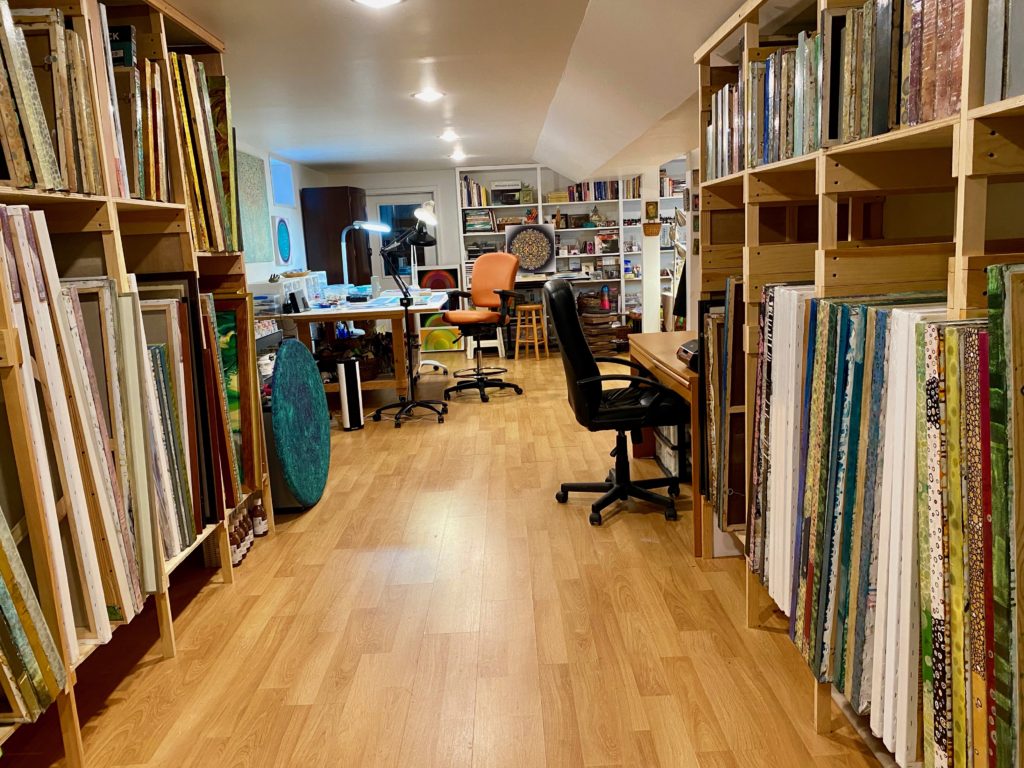31 Women – March 13th: Laura Gurton
Unknown Species #215, 2017
Oil, alkyd, ink on linen
An Interview with Laura Gurton
MKM: Tell me about your childhood, where did you grow up? Were you always creative?
LG: I was born in 1951 in Brooklyn, NY, into a family of artists. My childhood was filled with museum visits, art books, the theater, ballet, foreign films, music, and art classes at the Brooklyn Museum. When I was young, my mother was enrolled in an art education program at Brooklyn College and became an art teacher. My father was a pianist and, when he was not working, he would be home practicing; our home was always filled with his music and he always tried to share with me and my sister his love for classical music and jazz. I also had an uncle who was a painter and printmaker. Everyone in the family had his and my mother’s paintings, etchings and linocuts hanging in their homes next to Picasso reproductions. I have fond memories of
creating art with my cousin in my uncle’s studio and drawing trees in Prospect Park with my mother. My artwork was always encouraged, validated, and displayed; my mother saved a lot of what I created then and I still have those early pieces. Actually, one painting that I made in the 6th grade won the honor of being exhibited in a children’s art exhibition at Lever House Gallery in New York City. I never saw that painting again, but I remember the feeling of seeing my work framed and on display in a gallery space, of watching strangers stand in front of it, observing, studying, and praising my work.
MKM: Where did you study art in college?
LG: For my first year of college, in 1969, I attended Philadelphia College of Art (now called University of the Arts). Although I loved the foundation year, I decided to transfer to The School of Visual Arts in NYC. In the early 70’s, SVA was not an accredited college and, although I had many well-known artists as teachers, I finished my 4th year of art school without a degree. SVA only became accredited the year I finished and by then I did not have the right credits for a BFA. So, when I was in my forties, I decided to return to SVA to complete my degree and to take art education courses to become a high school art teacher. A few years later I earned a Masters in Supervision and Administration in the Arts from a joint program run by the Bank Street College of Education and Parsons School of Design—an amazing experience that allowed me to work as a vice principal and the head of the art department at the high school where I taught.
MKM: Did you have any memorable teachers?
LG: I was lucky to have had a few women artists as teachers: May Stevens was so generous with her time and her willingness to share her experience, inviting my class to her loft in Soho; Marsha Tucker, who had just started the New Museum, taught a class about the art world; Audrey Flack and Alice Neel co-taught a painting studio. Having these women as teachers and role models made it seem quite possible that I could succeed as well. There were some male instructors who were also very memorable: I had Robert Pincus Witten and Monroe Denton for art history; Don Eddy and David Mann for painting studio; Sonnenberg, Bunnell and Blackburn for printmaking, all of whom were great teachers. I was happy to have Whitfield Lovell for art education and Leon Dylan for a technique class. The person who affected me the most was Lucio Pozzi. When I went back to SVA in my 40s, the fine arts department had a new procedure: in addition to regular coursework, students also had to meet with another artist to be evaluated at the end of each term. So, I had to present my work to Lucio Pozzi who encouraged me more than anyone else had until then. He loved my work and asked about my goals. When I told him that I planned to work full-time as an art teacher, he just shook his head and said “no, you must continue with your art.”

MKM: When you’re creating what’s your daily routine? rituals, patterns? Has your practice changed over time?
LG: When I am about to start a new piece, I clear my schedule and prepare to work uninterrupted for as long as I can. Sometimes I paint for 10-12 hours straight, working continuously. I usually do not answer the phone and only stop for short breaks. The next day I’m usually exhausted and need to rest, and then I start all over again.
For many years, when I was home with my daughters, I had no choice but to work for only a couple of hours here and there. It was difficult to have to stop when a certain part of the process was incomplete. When I was teaching high school art, it was almost impossible to paint at home after a full workday. I always tried to be a working artist, but it was not until my children grew up and I was able to figure out how to support myself without teaching that I was I able to concentrate full-time on my work.
MKM: Do you focus on a specific medium or combinations of mediums?
LG: I have worked with oil paint mixed with alkyd on linen and on panels. I have also painted on top of panels on which I have first made reliefs with thick paper and matte board. That technique was inspired by the collagraph plates I used in printmaking. I have worked with acrylics on canvas and on clay board panels. I use the clay board like a scratch board, using a fine point to create textures with cross hatching and fine lines. I’ve experimented with encaustics, painted with textured gels and pastes, and, in the past few years, I’ve also developed a portfolio of digital art. I digitally manipulate photographs of my oil paintings, print the images on paper, and then work on top of the image with a variety of mediums: colored pencils, ink, gouache, metallic paint, sequins, rhinestones, beads, so as to create one of a kind mixed media pieces. I also recently added animation to the mix, and I am starting to collaborate with various musicians to create videos of my animated shapes with a musical score. I will always paint, but I have plans to exhibit the videos in galleries on a screen or projected on a wall. Right now, they are on Instagram and Facebook.
MKM: What themes do you pursue?
LG: My paintings consist of concentric circular lines and colors that mimic pieces of agate, rings inside of trees, mold, other patterns in nature and—most importantly—microscopic cells. I once read that when humans are born, they have an instinctual attraction to the shape of concentric circles, which makes sense since the nipple is the first shape they need for survival. I have always been fascinated with the idea that we have instincts towards shapes. My paintings are titled the Unknown Species, a phrase that suggests that my shapes are alive. Since all of the paintings have multiple shapes varying in sizes, I see them as families that have gone through the reproductive system and are related to each other.
My way of applying paint remains constant from painting to painting, and yet, as in nature, there is still a variety in the work, revealed by the choice of colors, the relative density of the circular forms, and the overall flow of the imagery. Some paintings seem tranquil, while others I find highly energized. Some of them are reminiscent of landscapes, reinforcing the theme of the shapes in the natural world. I see the shapes with their concentric circles as representing time itself, displaying their growth like the rings in a tree which come with age.
My digital art, the Bits and Pieces Series, developed directly from photographic images of my paintings. I became intrigued with the complex patterns that developed by manipulating the image and I liked being able to see how the same image looks in various color combinations. The cellular shapes in all my paintings, digital art, and videos, which echo naturally occurring shapes, repeat the rhythms of life and existence.
MKM: Is there an artwork you are most proud of?
LG: My Unknown Species paintings are executed on the floor and I need to be able to reach the center of the canvas to be able to paint. For a while, none of my paintings were larger than 36” wide. I then realized I could do multiples, with three or more panels that were each 60” x 36”, but I would need to paint them all at the same time for them to look like one painting. The first time that I completed a triptych where the panels all looked like they belonged together was a challenge that I was proud of.
MKM: In your art career, what has been a seminal experience?
LG: After four years of painting in my present studio, a gallery I was connected to told me they received a request for applicants to exhibit in the Pallazzo Bembo, a collateral event of the 2013 Venice Biennale. I applied and got into the exhibit Personal Structures. I knew that the Venice Biennale was the first worldwide art fair and very prestigious, but what I loved the most about it was being part of an international project with artists from all over the world. It will always be one of the most amazing experiences that I have had in my career.

MKM: Do you have a sense of connection to a particular woman artist from art history or present day?
LG: I first learned about Paula Modersohn-Becker in an art history class in 1993 and I felt a connection to her because she painted many portraits of children, pregnant women and nudes, some breastfeeding. At the time I was painting portraits of my daughters and their friends. I was intrigued by her abilities, the beauty of her paintings, and the short synopsis of her life that my art history teacher presented to the class. I then found the book Paula Modersohn-Becker: The Letters and Journals and learned more about her life—that at times she left Germany, her husband, and her stepchildren to paint in Paris. The more I read, the more connected I felt to this German woman who died in 1907. She wrote about her life as an artist and the struggles she had with the expectations her family, her husband, and society put on her as a woman and as a wife; I identified with her struggles. She was incredibly brave for the time period.
MKM: Who are your female role models from history or present day?
LG: I came of age during the 60s and 70s and was influenced by Gloria Steinem and Andrea Dworkin, among others. I was interested in the suffragettes and in women’s history, joined women’s support groups, and tried to raise my daughters thinking about what they were up against. Today I appreciate the Guerrilla Girls, women’s marches, and my daughters, both very amazing and powerful women.
MKM: What’s the best advice you’ve been given?
LG: Although I get accepted to many exhibitions, I still get rejected at times. The best advice that someone once gave me is to not take rejection personally and to just keep working… and know how lucky I am just to be able to create and be part of a community of worldwide artists.



